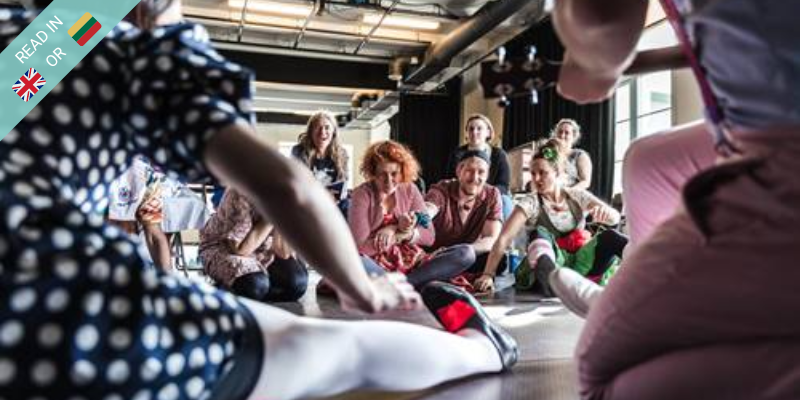Read in Lithuanian
In the first week of April, the second artistic laboratory on Autism of ClowNexus took place in Lithuania. Project partners from Lithuania, Austria, Croatia, Hungary, Finland and Spain gathered in Vilnius, the capital city. The participating clown artists continued to deepen their knowledge and explore the world of the senses in order to find the best tools to interact with autistic children.

Throughout the week, different lecturers shared their knowledge about different tools and methods that could be useful in the daily work of the clowns. Together with Dr. Solveiga Zviceviciene, a music, dance and movement therapist, the actors discussed communication models and its use in arts therapy. Kristina Radzvilaite, a mother raising a child with autism, shared her personal experience on coping with everyday challenges. Music therapist and psychologist Mintaute Sudžiute talked about making contact with the help of music. The Clownexus group was also invited to the “Theater of senses”, where the founders of the theater, Director Karolina Zernyte and set designer Sarune Peciukonyte, led a workshop on “awakening senses”. All workshops within the Artistic Laboratory focused on the practical application of concepts and approaches so that the participating artists could try and experience the effects of the artistic means by themselves.
The goal of ClowNexus is to assemble a palette of tools from different art forms, such as dance, music, movement therapy, theater of senses, to create formats that are adapted to the specific needs of children with autism.

During the workshops the clown artists explored which tools are best for making contact, which are best for creating a game, and which are suitable for working with children, parents or staff. In different countries the clowns meet the target groups in a variety of contexts – individually, in groups, or sometimes they directly work with carers or healthcare staff.
Every lecturer emphasized the same message – right at the beginning of an encounter you need to create a connection with the child. If there is no meaningful contact, the child won‘t be interested in what you have to offer. If this core moment is missed, the magic of a participatory performance will not happen. Once you gain the child’s attention you can play, joke and it will have an impact on the child. This, of course, is true for any child, but working with autistic children is more challenging because it‘s harder to read the signs they send us. Therefore, it is very important not to rush and to take the time to see and hear a particular child – to feel individually what could be THE key to connect with them.

Reuturning home after the laboratory in Vilnius, the local teams will continue to explore the selected artistic tools with local audiences – what works best in a given situation and how the audience responds. We look forward to future meetings and feel curious what significant change this adventure will bring.





Recent Comments